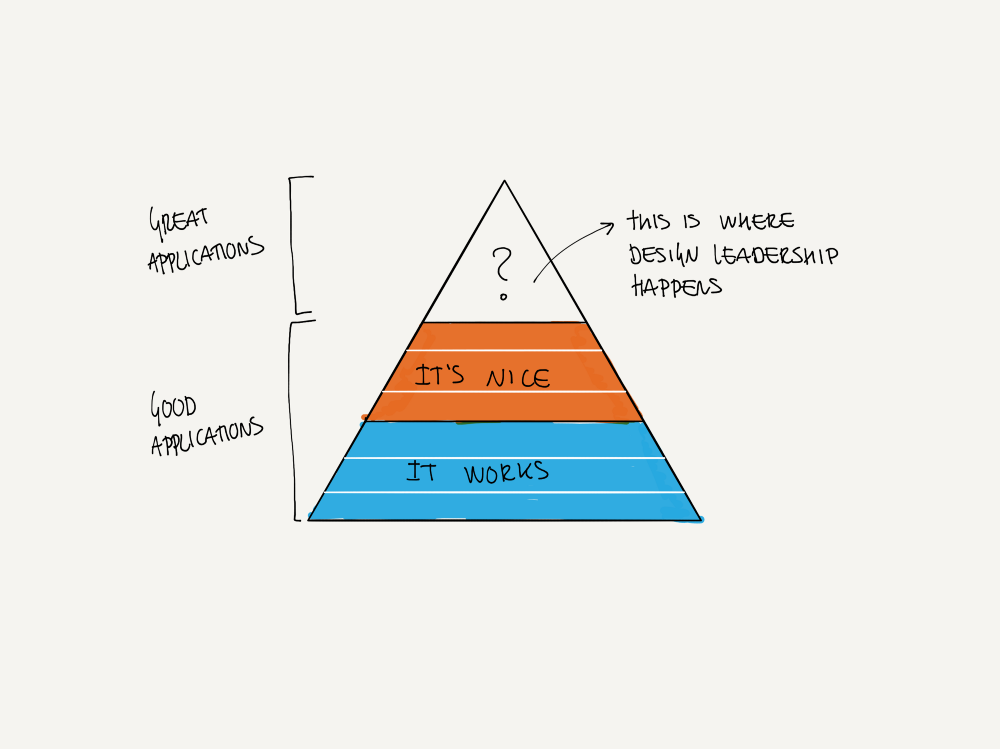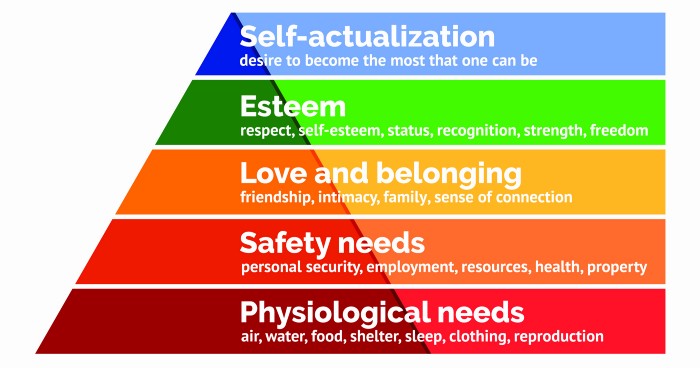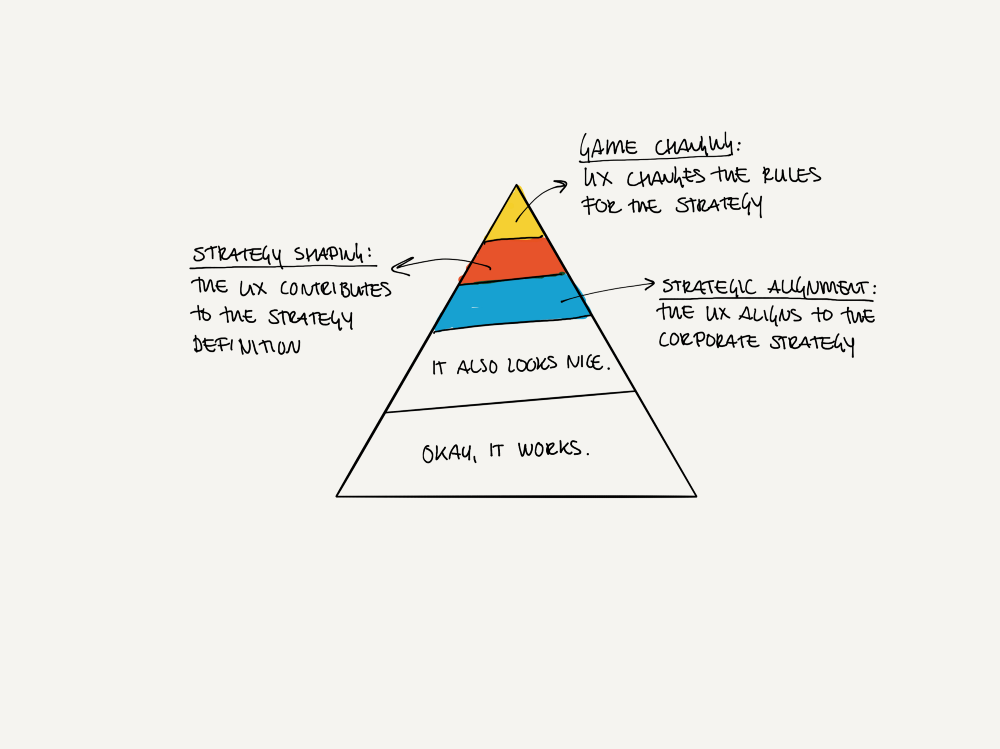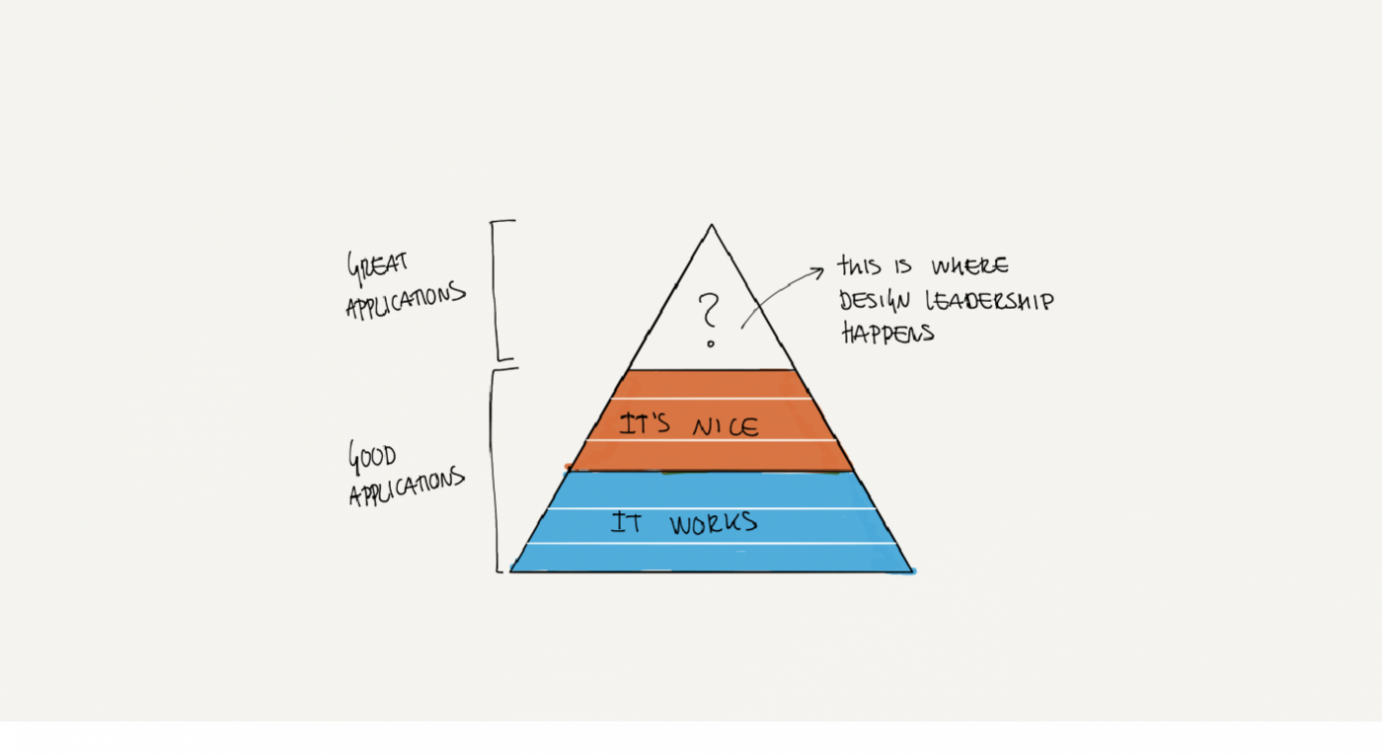If you do a Google search on “UX pyramid”, you get lots and lots of UX pyramids. If you take a closer look, you’ll see that most people agree about the bottom of the pyramid. Applications should be functional, usable, reliable. No arguments here. If things don’t work, the UX will suck. If we move up to the mid-section of those pyramids, we see that there is also a consensus about the niceness of the experience. Experiences should be desirable, esthetically pleasing, pleasurable, enjoyable, delightful. There are more different terms that we find here but the gist is the same: the experience should be nice. So at the bottom, the pyramids say the application should work, in the middle they say they should be nice. A good application works and is nice to experience, looks nice. Good applications solve the majority of business needs. It takes a lot of skill to make a good application. But I am interested in the top of the pyramid, when we move from good to great. That is where design leadership happens for me.

A basic structure for a UX pyramid
What happens at the top of the UX pyramid?
You see that some pyramids even stop at the nice part: delightful, pleasurable. Some pyramids have a top that talks about significance, meaningfulness. Those pyramids are all based on the pyramid of needs by Maslow. At the top of that pyramid, we find self-actualization: the desire to become the most that one can be. If we map that to the UX pyramid, the question becomes: what is the most that UX design can become? When I think about self-actualization, I think about things like purpose, of contributing to something that is bigger than yourself.

Pyramid of needs by Maslow
What can UX design contribute that is bigger than itself? What can UX design do that goes beyond the application it designed? These are the questions of design leadership.
What is the most that UX design can become?
UX aligned to strategy
If UX design just focuses on the application it is designing, it cannot contribute to something bigger than that application. Focussing on the things that are bigger than the application is strategy. How can the application contribute to the strategic goals of an organization? The application is built for a reason as part of a strategy. If UX design wants to add more value, it should design the application in a way that it helps to execute on the strategy of an organization. This requires thinking about what the strategy is, how it translates to the application. We need a strategy for the application that is aligned with the bigger strategic goals of the organization.
UX shaping strategy
If we take this up one notch, we see that UX design can also shape the strategy of an organization. Big part of the strategy of most organizations today is the digital strategy. Big part of the way most organization can win in the digital world is by offering excellent user experiences. Digital transformation is basically making the strategy of an organization more digital-minded. Organizations need to leverage the possibilities of digital to stay relevant and competitive. UX designers are people who live and breathe digital. So they are in an excellent position to not just align to the strategy but to shape it. What is possible in the digital realm, creativity in the digital realm is the basis of a sound strategy in this digital age. To create a good strategy that is digital-minded, you need to get digital. And you have to get strategy. Most strategists get strategy, but getting digital is a different game and UX designers with a feeling for strategy can help shape engaging strategies. A lot of organizations are getting this and are positioning (UX) designers at the strategy table.
Game-changing UX
But there is one level above that in my vision of the UX pyramid. Organizations operate within a certain set of rules. Those rules are determined by the market they are in. The market has certain rules and the organization that can perform best within those rules, win. If the game is to have the fastest processor in a laptop for the least amount of money, the organization that can do this best wins. If the game is to offer the most luxurious way to spend the night for the least amount of money, the one who can deliver this wins. To win, organizations research what the rules of the market are, how well they perform on those rules and take action to align their organization to perform better. But there is another way to win. And that is to change the game. The traditional idea about finding out the rules and then align the organization to perform better within those rules is called red ocean strategy (because of all the sharks). Blue ocean strategy is finding parts of the ocean that have less sharks in them and then move there. That can be an innovative strategy. But there is a third way and that is to leave the ocean and move to land. On land, it’s not about who can swim the fastest. On land it’s about running. Other capacities count. The trick of changing the game is to create a game where your natural capacities give you an unfair advantage over others. If you are well equipped to run fast, you should not enter a swim competition but create a running competition. See how fast the fastest swimmers are on land.
Well, UX design can help change the game. That is the top of the UX pyramid for me. UX design is about uncovering the deepest needs of people and creating solutions that solve these fundamental needs that they didn’t even know they had in an engaging way. User insights combined with engaging, fundamental problem solving UX is the way you can change the game in a digital world. Think of all the cliché game changers like Netflix, Uber, AirBnB, Amazon, Spotify. They all solved a problem that people didn’t even know they had. Traditional user research, market research will never get you the insights needed for game changing UX. You need to dive deep, prototype, fail, think outside the box, question everything. And there are games on all levels and in all parts of the organization. Some games are internal. Great, game-changing UX design not only solves a deep fundamental need for the user, it also reshapes the organization. Look at any of the cliché game changers and they all have innovative ways to organize themselves. If you want to have game-changing UX, you also need game-changing organization. To develop and maintain game-changing UX, you need to be agile in some form. Traditional top-down scientific management doesn’t work.

Pyramid of needs by Maslow
It takes combining strategic thinking with UX but this is what the top of the UX pyramid looks like to me. Not all organizations are ready to be changed by UX and not every UX project is about the top of the UX pyramid. But the game-changing top of the UX pyramid is the most wonderful place to be for me. It’s the apex of purpose of UX for me. I’ve seen UX change organizations, UX go way beyond the application it was designing. At the top of the pyramid, UX is significant, meaningful, not just to the users but to the organization, the world. It’s good to look at UX from a user perspective, but UX is bigger than that at the top of the UX pyramid. The bottom 2 parts of the pyramid are about the user. At the top, it’s about more than that.






